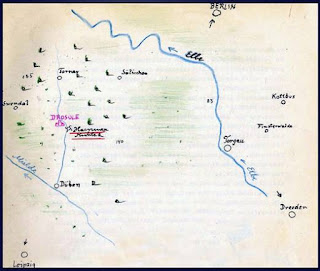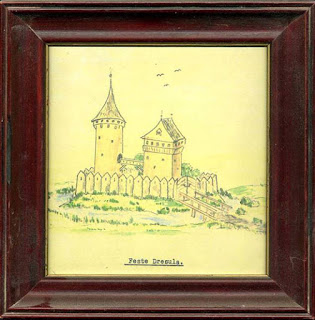GENERATION VI
CHRONOLOGY:
1385. August 24
VI.3 CUNRAT (CONRAD) von BENHUSEN UND JUTHE
doc. Sep. 23, 1337
CHRONOLOGY:
SAXONY
This manuscript was researched by the Baron Goetz von Houwald's father who was a historian. However, since that time, much information was lost during the war (but much more has been subsequently found and incorporated into this study.) Of particular interest, is Baron Houwalds note on the side of page ?, telling of Dressel family ownership of small pieces of property after their estates were sold.
VI.4 KNIGHT RUDOLPH von der DRESSEL
called RULE de DRYSULE
nee von BEENHAUSEN
doc. 1319 - 1323
BELIEVED to BE SON OR RELATIVE to JOHANNIS von BENHUSEN V.1
Founder of the Dressel branch of the Beenhausen family, first lord of Dreisiel and first Dressel family head. Knight in the service of Duke Rudolph of Saxony, (became Duke in 1298, died 1356)
CHRONOLOGY:
1319: Sept. 30, Berlin, Brandenburg. Among others, the knight Rule de Drysule is a witness to the document which states that the duke Rudolf of Saxony, guardian for his ward Agnes, the markcountess of Brandengburg, together grant to the city of Spanow various rights and privileges which are now posessed by the city of Berlin, pertaining to the sale and posession of property, transportation of grain, and the minting of money. p1.1.
This is the oldest Dressel family document known to exist pertaining directly to the Dressel branch.
1319: Oct. 13, Berlin, Brandenburg, Herr Rule von Dressol (Sir (Lord) Rudolph von Droessel,) appears as a witness for Duke Rudolph of Saxony for a document that gave the city of Guben the right to coin money, be free of duty charges, and be in control of the protection rights pertaining to the Jews. The document is in German, p1.2.
1319: Oct. 14, Her Rule van Dresul Sir (Lord) Ridolph von Droessel appears as a witness for Duke Rudolph of Saxony for a document that confirms the privileges of the old cities of Brandenburg. The document is in German, p1.3.
1319: Oct. 14, Rathenow, Brandenburg, Rulevus de Dresule Rudolph von Droessel, appears as a witness for Duke Rudolph of Saxony for a document that as the guardian of the Markcountess Agnes the Duke grants the city of Rathenow all the privileges and freedoms that the cities of Berlin and Spandow enjoy. This document is in German, p1.4..
1319: Oct. 26, Guben, Brandenburg, Her Rule von Dusule "Sir (Lord) Rudolph von Droessel," appears as a witness for Duke Rudolph of Saxony for a document that grants a "Lehnbrief" to Hannes and Richart, Lords of Cottbus.
This document is in German and is considered one of the oldest documents in the German language, p1.5.
1319: Nov. 4, Rule dictus de Drisulen, "Rule (Rudolph) who is called de Drisulen "appears as a witness for Duke Rudolph of Saxony for a document that states the privileges of the city Brietzen. This document is in Latin, p1.6
COMMENT:
The phrase "dictus de Drisulen" is translated to mean that Rule is now called or known as de Drisulen, implying that formerly he was known by another name, (which is believed to be von Bennhausen) and that now he is called by the name of his estate which he (recently) received in fief for his knightly services to the Duke.
1319: Nov. 24, Spandau, Brandenburg, Rule de Drisule, appears as a witness for Duke Rudolph of Saxony for a document that takes the Bishopric of Brandenburg under his special protection. This document is in Latin, p1.7.
1323: Dec. 24. The knights Rule and Coneke von Drisule are witnesses to the document that the duke Rudolf von Sachsen-Wittenberg pledges the city and castle of Hitzacker with all its income, with its higher and lower jurisdictions, with income from duty, with its villages, and other possessions on the brothers Hinze, and Ulrich von Warmstorf and on (Tamme) Loser. This document is in German, p3. see exhibit 35.3.COMMENT:
In 1319 Rudolph was a mature man who was usually called by his nick name Rule, he was a knight, he was a soldier-officer who fought in the Duke's army before 1319 and was a vassal of Duke Rudolf and who held a fief (estate) called Drisule from the Duke which produced the income necessary to support him and his family and his responsibilities to the Duke in time of war. Rudolf was probably the father of Conrad. Under these circumstances 1270 is a acceptable date for Rudolph's birth.
The following could be a description of Rule; by the beginning of the 14th century the knight's "helm had replaced the helmet, covering the head completely, and later to be equipped with a visor to protect the eyes: the wearer was unrecognizable, and the elaborate crests were worn to distinguish him from other knights in similar attire. The whole body was now covered encased in armor of varying degrees of flexibility. A series of plates attached to the basic mail armor protected the arms, legs, chest and back, and a quilted garment was worn beneath to lessen the discomfort. Besides this, the warhorse would bear a mail or cloth trapper, often both, and a chamfron on its head, as protection. All this was extremely expensive and not easy to obtain." s Barber Knight p.33
Location of Dresula castle in relation to Leipzig, Dresden, and Berlin
Dresula Castle
According to legend, Rule planted this tree in the beginning of the 14th century






Comments
Post a Comment